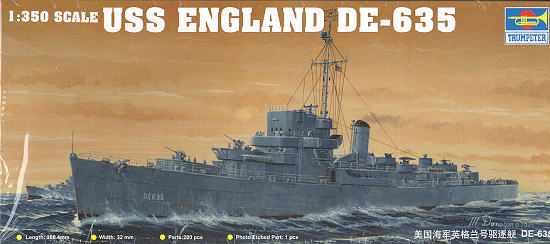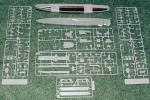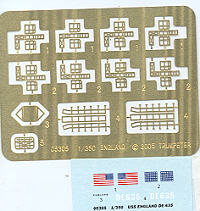
| KIT: | Trumpeter 1/350 USS England |
| KIT #: | 05305 |
| PRICE: | $32.95 MSRP |
| DECALS: | One option |
| REVIEWER: | Scott Van Aken |
| NOTES: | Includes photo etched fret. |

| HISTORY |
USS England, a 1400-ton Buckley class escort ship, was built at San Francisco, California. Commissioned in December 1943, she was assigned to escort and patrol duty in the south Pacific area early in 1944. Between 19 and 26 May 1944, while serving as part of an anti-submarine hunter-killer group, England sank the Japanese submarines I-16, RO-106, RO-104, RO-116 and RO-108. A few days later, she joined other ships in destroying a sixth enemy submarine, RO-105. This impressive feat, facilitated by poor Japanese Navy communications security, remains unsurpassed in U.S. Navy history and earned England a Presidential Unit Citation. It also prompted Admiral Ernest J. King, the Chief of Naval Operations and Commander in Chief U.S. Fleet, to proclaim "There'll always be an England in the United States Navy", a commitment honored between 1963 and 1994 by the service of USS England (DLG/CG-22), but which appears to be currently in abeyance.
Through the rest of 1944 and into 1945, as the active war zone progressed ever further toward Japan, England continued her southern and central Pacific escort and patrol work. Beginning in late March 1945, she took part in the invasion of Okinawa and subsequent operations in that area. While on picket duty on 9 May, she was hit in her forward superstructure by a suicide plane, resulting in serious damage to the ship and the loss of 37 lives among her crew.
England was sent to the U.S. east coast for repairs, arriving at the Philadelphia Navy Yard in June. While this work was underway, she also began conversion to a fast transport, with the new hull number APD-41 assigned in July. However, soon after the end of World War II, conversion was cancelled. The partially rebuilt ship was decommissioned in October 1945. In November 1946, USS England was sold for scrapping.
USS England was named in honor of EnsignJohn Charles England, USNR, who was killed in action on board USS Oklahoma (BB-37) during the 7 December 1941 Pearl Harbor air raid.
The Buckley class destroyer escorts were 102 destroyer escorts launched in the United States in 1943 - 1944. They served in World War II as convoy escorts and anti-submarine warfare ships. The lead ship wasUSS Buckley (DE-51) which was launched on 9 January 1943. The ships had General Electric steam turbo electric drive engines. The ships were prefabricated at various factories in the United States, and the units brought together in the shipyards, where they were welded together on the slipways.
Forty-six of the Buckleys were delivered to the Royal Navy under the Lend-Lease agreement. They were classed as frigates and named after captains of the Napoleonic Wars, and formed part of theCaptain class frigates along with 32 ships of the Evarts class.
After World War II, most of the surviving units of this class were transferred to Taiwan, South Korea, Chile, Mexico and other countries. The rest were retained by the US Navy's reserved fleet until they were decommissioned.
| THE KIT |
 Trumpeter's reputation as a maker of fine ship kits continues with this one on the USS England, a Buckley class destroyer escort. The really nice thing about this kit is that it is large enough to have some nice detail, but not so big that it takes over the room. That makes it the perfect kit for those who like ships, but are light on space. It is also a great kit for those interested in getting into the genre.
Trumpeter's reputation as a maker of fine ship kits continues with this one on the USS England, a Buckley class destroyer escort. The really nice thing about this kit is that it is large enough to have some nice detail, but not so big that it takes over the room. That makes it the perfect kit for those who like ships, but are light on space. It is also a great kit for those interested in getting into the genre.
The kit includes 177 parts in Trumpeter's usual medium grey plastic. There is a very nicely done photo etched fret that includes the radar antenna, covers for all the depth charge racks, and the 'hedgehog' rack. These are super simple to bend and install so even those like me who are all thumbs with P.E. will have little trouble.
In common with other Trumpeter kits, the bulkheads on the weather decks are separate so that you can paint them apart from the decks then assemble things and do any touch-up needed. There are the usual myriad of AA guns as this is the ship as it was in 1945 before the Okinawa campaign. Since two of the sprues are duplicated, you'll find yourself with a few extra parts. The kit can also be done as either waterline or full hull and a display stand is provided for those wishing the second option. naturally, drive shafts and screws are provided .
can paint them apart from the decks then assemble things and do any touch-up needed. There are the usual myriad of AA guns as this is the ship as it was in 1945 before the Okinawa campaign. Since two of the sprues are duplicated, you'll find yourself with a few extra parts. The kit can also be done as either waterline or full hull and a display stand is provided for those wishing the second option. naturally, drive shafts and screws are provided .
Instructions are all we've come to expect from Trumpeter in that they are clear and easily to follow. The painting and markings guide is in full color and represents the ship in the scheme with overall Navy Blue vertical surfaces with the deck in Deck Blue. Makes for a bit of a dark ship and frankly, I wish that Trumpeter would indicate in the construction sequences the colors of the various deck fittings and such as they are very difficult to see in the color sheet. The box art helps somewhat but it would still be nice to have more info. Decals for the one ship is provided consisting of numbers and flags.
| CONCLUSIONS |
I'm sure that ship builders have been waiting a long time for an interesting and important ship like this to be produced. What's more, since so many were built, one could do a number of different ships of this class with the right references. I'm sure that there were differences between them as the war progressed and research should point them out. I'm looking forward to starting on mine as I've not built a non-submarine vessel in quite some time.
| REFERENCES |
August 2006
My thanks to Stevens International, the importer of Trumpeter and other fine kits. If you would like your product reviewed fairly and quickly by asite that has nearly 325,000 visitors a month, please contactme or see other details in the